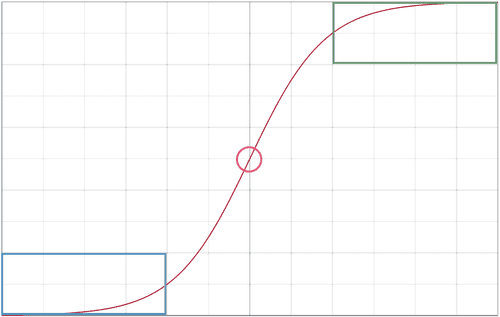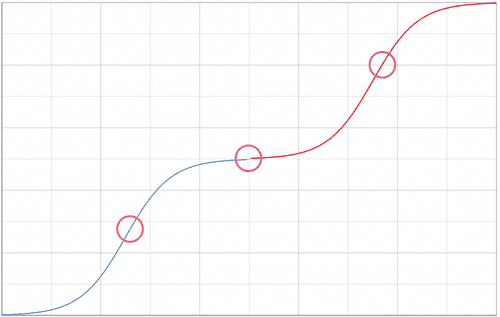Inflection Points
2020 May 19th
Inflection Points
This blog was born amidst the COVID-19 global pandemic. The past few weeks have presented unexpected constraints and freedoms both. One example of this duality has been the drastic and immediate change (and dissolution) of routine. Fortunately, change spurs creativity and thought. This brings us to my hopes for this blog: a home for some of my writing-down-worthy ideas and reflections.
Inflecting
Thus we arrive at an inflection - A change in pitch or loudness of voice. Today, I wanted to explore the common term inflection point and an associated mental model that I use to explore and reason about my growth.
Consider Inflection Points :
- In music and speaking: a noted modulation; delivers emphasis
- In history: a moment of significant change
- In mathematics: a point on a curve that separates a positive growth from a negative growth (and vice versa)
I believe that inflection points are important to recognize and reflect on. Specifically, I want to lean into the mathematical definition to explore how they can be helpful for navigating one's path. Also, this means I get to map it to some nice graphs.
S-Curves
Sigmoid functions or S-Curves are a class of mathematical functions that have an S-shaped curve.

The curve's small initial values (blue region), accelerating growth, and tapered stagnation (green region) can be mapped to a number of everyday processes. The adoption of innovative tech follows this pattern with opinion leaders, majority, and laggards. Similarly, population growth models also follow S-curves. Growth is often not purely exponential and will be limited by some carrying capacity - introducing a boundary and forcing the tapered S-shape.

On the graph above I have marked the inflection point of the S-curve with a pink circle. At this point the growth (or acceleration) of the function begins to decrease.
Two Inflection Points
One sigmoid function that is especially interesting is the Learning Curve. An idealized learning curve for a given topic follows that same Sigmoid function with Experience along the X-axis and Learning on the Y-axis. Your first steps of Experience (even small) produce small amounts of Learning. Continued Experience leads to larger and larger increases in Learning until you reach a point of inflection - at which point your growth rate begins to decline.
This may sound like a negative or very sour thing. It is not.
The inflection point on this graph signals moving towards mastery - reaching your full potential in learning that topic.
Let's call this the mastery inflection point - which hopefully you consider a positive milestone. Or at the very least it does not denote a gloomy ending.

Our (mathematics') definition of inflection describes the mark between positive growth and negative growth (and vice versa). Although we may approach a mastery limit of our growth for one given topic - our overall growth does not have to end there. If we begin a new topic we can continue our overall growth and learning.
Beginning a new journey marks another inflection point (the point between our blue and red S-curves). As we move from mastery to a new (and maybe even daunting) area of study, our growth begins to accelerate again. Let's call this the journey inflection point.
Plotting My Growth
I am very grateful for the journey that I have had so far. I can point to a number of things that ended up being inflection points for me.
2014 - Journey Inflection Point: My first job in technology (and in games!). I had my first ever mentor for development and I was exposed to industry code for the first time. I realized what architecture can mean for software and that a codebase structured with purpose can deliver meaning for other developers.
2016 - Mastery Inflection Point: I left game development and started building web software. My boss described to me the idea of craft - consider carpenters who apprentice for many years, honing their skills and creativity for their discipline. Software as a craft, although often approached through academia, is worth spending time practicing and creatively exploring. Don't let yourself be robbed of the experience of working under other skilled crafters. This was a mastery inflection point for me, I was no longer a beginner, and was beginning the long transition to mastery.
2017 - Journey Inflection Point: I took the leap to apply to a large software company. More importantly, my friends sat with me after I received the offer. I was awash with uncertainty, I felt imposter syndrome, and I was afraid to move away. Their encouragement led me to a fantastic co-op and further down the line full-time employment at that company.
2018 - Mastery Inflection Point: I'm exposed to not just one brilliant crafter working on a project, but hundreds. I can reflect and think about what makes software feel good - for both the user and the developer. A new perspective on building software (and thinking about problems at scale) marks another transition away from that beginner status.
I started this article mentioning that this blog will be a journey inflection point for me. I think that it will help me learn to be a better writer and a more vulnerable individual as I share on this platform. It will help me modulate my voice. I hope that you take time to think about your own inflection points and where you may be on your own learning curve. I encourage you to try new things and start new journeys yourself!
Thank you for reading. Thank you for exploring ideas with me.

